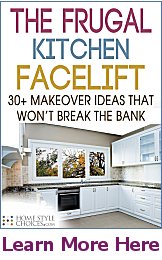Home Improvement Financing
A Look At Your Options
Home improvement financing can take on a variety of forms. That's a good thing because the more flexibility you have, the greater your chances of actually seeing your project become a reality. The question is figuring out which financing option is going to be the best one for your particular situation. To that end let's take a look at the choices you have available to you.
Self-Financing Of Renovation Projects
Cash is always the best option for funding home improvement projects. There are no interest charges, no credit criteria to meet, and no risk of default if financial situations change. For small projects such as resurfacing a bathroom, replacing a tile floor, or other light remodeling, cash is by far the simpler way to go.Credit cards and personal loans offer options for projects that are too big to cover with cash or savings, but not big enough to warrant mortgage refinancing or renovation loans. While these home improvement financing options typically involve higher interest rates, for those with less than stellar credit or those in need of quick funding, the higher rate can be a worthwhile trade-off.
Personal loans may also be more attractive because these loans use collateral other than the home, such as investments, life insurance policies, or 401(k) savings.
Second Mortgages As Home Improvement Financing
Most homeowners already have a mortgage on their homes. With enough equity, a second mortgage helps finance renovation projects. In this regard, homeowners have two options; a home equity line of credit (HELOC) or a home equity loan.A home equity line of credit is a type of revolving credit, much like a credit card. Funds are drawn from the HELOC account as needed, with the home serving as collateral against money borrowed. The National Association of Home Builders reports that HELOCs range between 75% to 80% of the appraised value of the home, less any mortgage balance owed. Interest rates are variable, based on the current prime interest rate. However, homeowners only have to make payments when money is drawn out of the account. This form of home improvement financing is ideal for numerous small projects, or ongoing renovations.
A home equity loan is slightly different than a HELOC in that funds are dispersed in a lump sum. Payments are made over time, with fixed interest rates over the term of the loan. These renovation loans are ideal for large or one-time projects such as an addition, kitchen remodel, or garage conversion.
Existing Mortgage Refinancing
By far, the most common way to finance home renovations and rebuilding is through mortgage refinancing. The benefit is that homeowners have more options than with second mortgages, and only have to make one monthly payment. Naturally, interest rates play an important role in deciding if mortgage refinancing is the best option. If a refinanced loan involves a higher interest rate than the current mortgage, a second mortgage could be a better option. Some of the options available include 203(k) mortgages through the FHA, traditional cash-out mortgage refinancing, or B and C loans.Older homes in need of repairs and upgrades may be eligible for a 203(k) mortgage. These loans pay off the existing mortgage as well as providing funds for renovations, all wrapped up into one loan, with one mortgage payment. Loan amounts are based on the improved value of the home, rather than current market value.
Traditional cash-out refinancing allows the borrower to take out a loan for the full value of the home. The old mortgage is paid off and the homeowner keeps the cash difference to fund renovation projects.
Alternatively, B and C loans are offered by financial institutions beyond just banks, such as credit unions or brokerage houses. These loans are typically marketed for debt consolidation and carry higher interest rates. However, B and C loans often have less stringent qualifying criteria.
Every borrower's situation is different. Credit history, current home value, mortgage balance and other factors can influence what home improvement financing options are available to individual borrowers. Before taking out a second mortgage or refinancing a mortgage, it's advisable to consider several funding offers. You should compare factors such as payment amounts, interest rates and other loan terms before deciding on a specific funding solution.
Here's More Related Info That Might Be Helpful...
Home Design Help - Whether you're looking to upgrade a small bathroom or build a new home completely, find out what kind of help is available in this article.
The Remodeling Contract - Getting financing is one piece of the puzzle but the other important part of any home improvement is the contract. Find out what's involved in this article on the importance of the remodeling contract.

